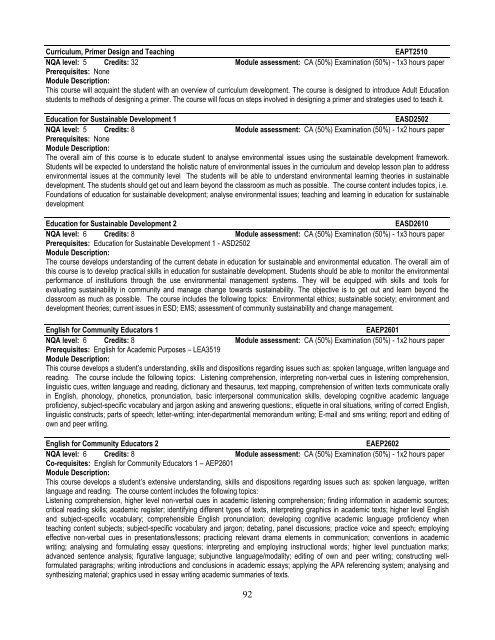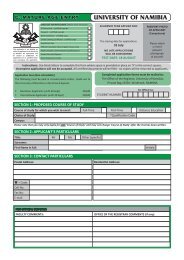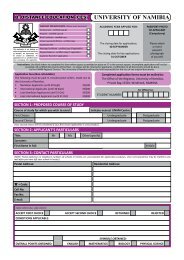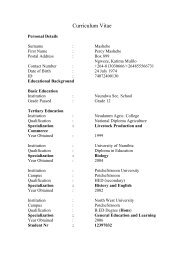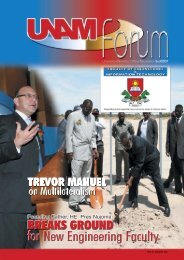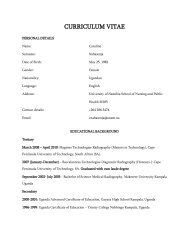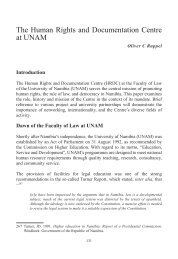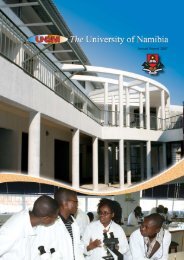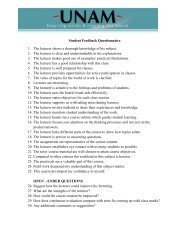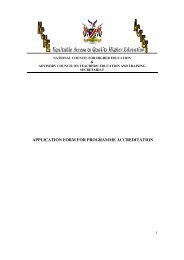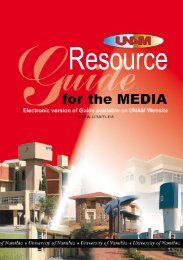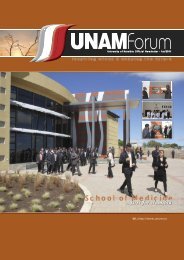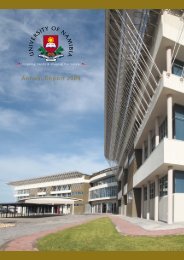UNIVERSITY OF NAMIBIA CENTRE FOR EXTERNAL STUDIES ...
UNIVERSITY OF NAMIBIA CENTRE FOR EXTERNAL STUDIES ...
UNIVERSITY OF NAMIBIA CENTRE FOR EXTERNAL STUDIES ...
You also want an ePaper? Increase the reach of your titles
YUMPU automatically turns print PDFs into web optimized ePapers that Google loves.
Curriculum, Primer Design and TeachingEAPT2510NQA level: 5 Credits: 32 Module assessment: CA (50%) Examination (50%) - 1x3 hours paperPrerequisites: NoneModule Description:This course will acquaint the student with an overview of curriculum development. The course is designed to introduce Adult Educationstudents to methods of designing a primer. The course will focus on steps involved in designing a primer and strategies used to teach it.Education for Sustainable Development 1EASD2502NQA level: 5 Credits: 8 Module assessment: CA (50%) Examination (50%) - 1x2 hours paperPrerequisites: NoneModule Description:The overall aim of this course is to educate student to analyse environmental issues using the sustainable development framework.Students will be expected to understand the holistic nature of environmental issues in the curriculum and develop lesson plan to addressenvironmental issues at the community level The students will be able to understand environmental learning theories in sustainabledevelopment. The students should get out and learn beyond the classroom as much as possible. The course content includes topics, i.e.Foundations of education for sustainable development; analyse environmental issues; teaching and learning in education for sustainabledevelopmentEducation for Sustainable Development 2EASD2610NQA level: 6 Credits: 8 Module assessment: CA (50%) Examination (50%) - 1x3 hours paperPrerequisites: Education for Sustainable Development 1 - ASD2502Module Description:The course develops understanding of the current debate in education for sustainable and environmental education. The overall aim ofthis course is to develop practical skills in education for sustainable development. Students should be able to monitor the environmentalperformance of institutions through the use environmental management systems. They will be equipped with skills and tools forevaluating sustainability in community and manage change towards sustainability. The objective is to get out and learn beyond theclassroom as much as possible. The course includes the following topics: Environmental ethics; sustainable society; environment anddevelopment theories; current issues in ESD; EMS; assessment of community sustainability and change management.English for Community Educators 1EAEP2601NQA level: 6 Credits: 8 Module assessment: CA (50%) Examination (50%) - 1x2 hours paperPrerequisites: English for Academic Purposes – LEA3519Module Description:This course develops a student’s understanding, skills and dispositions regarding issues such as: spoken language, written language andreading. The course include the following topics: Listening comprehension, interpreting non-verbal cues in listening comprehension,linguistic cues, written language and reading, dictionary and thesaurus, text mapping, comprehension of written texts communicate orallyin English, phonology, phonetics, pronunciation, basic interpersonal communication skills, developing cognitive academic languageproficiency, subject-specific vocabulary and jargon asking and answering questions:, etiquette in oral situations, writing of correct English,linguistic constructs; parts of speech; letter-writing; inter-departmental memorandum writing; E-mail and sms writing; report and editing ofown and peer writing.English for Community Educators 2EAEP2602NQA level: 6 Credits: 8 Module assessment: CA (50%) Examination (50%) - 1x2 hours paperCo-requisites: English for Community Educators 1 – AEP2601Module Description:This course develops a student’s extensive understanding, skills and dispositions regarding issues such as: spoken language, writtenlanguage and reading. The course content includes the following topics:Listening comprehension, higher level non-verbal cues in academic listening comprehension; finding information in academic sources;critical reading skills; academic register; identifying different types of texts, interpreting graphics in academic texts; higher level Englishand subject-specific vocabulary; comprehensible English pronunciation; developing cognitive academic language proficiency whenteaching content subjects; subject-specific vocabulary and jargon; debating, panel discussions; practice voice and speech; employingeffective non-verbal cues in presentations/lessons; practicing relevant drama elements in communication; conventions in academicwriting; analysing and formulating essay questions; interpreting and employing instructional words; higher level punctuation marks;advanced sentence analysis; figurative language; subjunctive language/modality; editing of own and peer writing; constructing wellformulatedparagraphs; writing introductions and conclusions in academic essays; applying the APA referencing system; analysing andsynthesizing material; graphics used in essay writing academic summaries of texts.92


